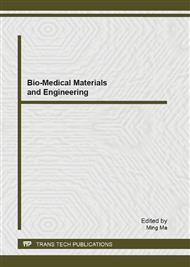p.299
p.304
p.309
p.318
p.322
p.328
p.333
p.338
p.344
Analysis of Structural Parameter and Design of Elbow Joint Rehabilitation Parallel Robot
Abstract:
Elbow joint is one of the body's important joints, most of the activities of the human body are inseparable from the elbow joint, and including taking and holding movements.In order to increase the workspace of elbow joint, a novel elbow joint rehabilitation parallel robot based on 2-DOF orthogonal spherical parallel mechanism is proposed. First, the position inverse solution equation of elbow joint is established. Further, the workspace of elbow joint is analyzed. The optimal structural parameters are obtained by use of the objective function of optimization method. Finally, the virtual prototype of elbow joint rehabilitation parallel robot is designed using optimal structural dimensions parameters.
Info:
Periodical:
Pages:
322-327
Citation:
Online since:
August 2013
Authors:
Keywords:
Price:
Сopyright:
© 2013 Trans Tech Publications Ltd. All Rights Reserved
Share:
Citation:


